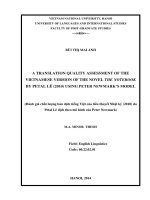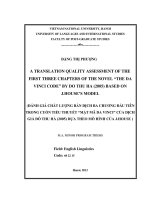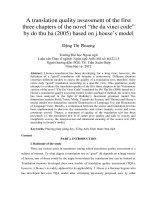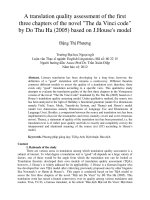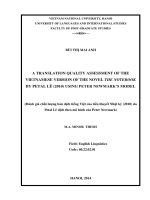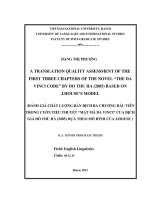a translation quality assessment of the first three chapters of the novel the da vinci code by do thu ha (2005) based on j.house's model = đánh giá chất lượng bản dịch ba chương đầu tiên trong cuốn tiểu thuyết
Bạn đang xem bản rút gọn của tài liệu. Xem và tải ngay bản đầy đủ của tài liệu tại đây (1005.85 KB, 83 trang )
VIETNAM NATIONAL UNIVERSITY, HANOI
UNIVERSITY OF LANGUAGES AND INTERNATIONAL STUDIES
FACULTY OF POST-GRADUATE STUDIES
o0o
ĐẶNG THỊ PHƯỢNG
A TRANSLATION QUALITY ASSESSMENT OF THE
FIRST THREE CHAPTERS OF THE NOVEL “THE DA
VINCI CODE” BY DO THU HA (2005) BASED ON
J.HOUSE’S MODEL
(ĐÁNH GIÁ CHẤT LƯỢNG BẢN DỊCH BA CHƯƠNG ĐẦU TIÊN
TRONG CUỐN TIỂU THUYẾT “MẬT MÃ DA VINCI” CỦA DỊCH
GIẢ ĐỖ THU HÀ (2005) DỰA THEO MÔ HÌNH CỦA J.HOUSE )
M.A. MINOR PROGRAM THESIS
Hanoi, 2012
Field: English Linguistics
Code: 60 22 15
VIETNAM NATIONAL UNIVERSITY, HANOI
UNIVERSITY OF LANGUAGES AND INTERNATIONAL STUDIES
FACULTY OF POST-GRADUATE STUDIES
o0o
ĐẶNG THỊ PHƯỢNG
A TRANSLATION QUALITY ASSESSMENT OF THE
FIRST THREE CHAPTERS OF THE NOVEL “THE DA
VINCI CODE” BY DO THU HA (2005) BASED ON
J.HOUSE’S MODEL
(ĐÁNH GIÁ CHẤT LƯỢNG BẢN DỊCH BA CHƯƠNG ĐẦU TIÊN
TRONG CUỐN TIỂU THUYẾT “MẬT MÃ DA VINCI” CỦA DỊCH
GIẢ ĐỖ THU HÀ (2005) DỰA THEO MÔ HÌNH CỦA J.HOUSE )
M.A. MINOR PROGRAMME THESIS
Hanoi, 2012
Field: English Linguistics
Code: 60 22 15
Supervisor: Trần Xuân Điệp, Assoc. Prof. Dr.
iv
LIST OF ABBREVIATIONS
ST
Source Text
TT
Translation Text
TQA
Translation Quality Assessment
TL
Target Language
SL
Source Language
SLT
Source Language Text
TLT
Target Language Text
TE
Translation Equivalence
v
TABLE OF CONTENT
PART I. INTRODUCTION 1
I. Rationale of the study 1
II. Scope and objectives of the study 2
III. Research questions 2
IV. Research methodology 2
V. Organization of the study 3
PART II: DEVELOPMENT 4
CHAPTER I. THEORETICAL BACKGROUND 4
I.1. Translation theory 4
I.1.1. What is translation? 4
I.1.2. Translation procedures and methods 5
I.1.3. Translation equivalence 6
I.2. Views and models of translation quality assessment 7
I.2.1. Hatim & Mason‘s model (1990) 7
I.2.2. Peter Newmark‘s model 7
I.3. Development of J .House‘s model 8
CHAPTER II: LITERATURE REVIEW 12
II.1. Application of House‘s model in Vietnam. 12
II.2. Application of House‘s model in other countries. 12
CHAPTER III: METHODOLOGY AND PROCEDURES 14
III.1. Subject of study 14
III.2. Methodology 14
III.3 Data Collection Procedure 14
III.4. Data Analysis Procedure 15
CHAPTER IV: FINDINGS AND DISCUSSION 16
IV.1. Brief introduction of the original text 16
IV.1.1. Writer 16
vi
IV.1.2. Readers 16
IV.1.3. Purpose 16
IV.1.4. Organization 16
IV.1.5. Summary of the original text‘s content. 16
IV.2. Findings of the study 17
IV.2.1. Analysis of the original text based on J. House‘s model and Halliday‘s
systemic-functional model. 17
* Statement of Function 26
IV.2.2. ST and TT comparison 27
IV.3. Discussion: statement of quality 39
PART III: CONCLUSION 42
I. Recapitulation of main ideas 42
II. Limitations of the study 42
III. Recommendation for further research 43
REFERENCES 44
APPENDICES I
Appendix 1: First three chapters of ―The Da Vinci Code‖ by Dan Brown. I
Appendix 2: First three chapters of ―Mật mã Da Vinci‖ by Đỗ Thu Hà. XVII
1
PART I. INTRODUCTION
I. Rationale of the study
There are various areas in translation among which translation quality
assessment is a subject of interest. To what degree a translation text is ―good‖ all
depends on a large variety of factors, one of those would be the angle from which the
translation text can be looked at. Translation theorists developed their own models of
translation quality assessment (TQA); however, J. House‘s is widely adduced for its
applicability. J. House is a German linguist who has developed her own TQA model
after criticizing previously proposed ones by other linguists like Newmark‘s or Hatim
& Mason‘s. This paper is conducted based on her TQA model to assess the first three
chapters of the novel ―Mật mã Da Vinci‖ by Đỗ Thu Hà (2005). This translation work
has raised a heated controversy over its quality among various translators and readers.
Tran, T.C.D, a famous translator, in his article ―Bản dịch Mật mã Da Vinci: Một thảm
họa dịch thuật‖ in the newspaper ―Văn Nghệ‖ (as cited in
indicates
that the translation version is the result of the translator‘s lack of knowledge of
language, history, and religion in combination with her carelessness, laziness and the
publisher‘s irresponsibility and shamelessness. Another article discussing this issue is
―Mật mã Da Vinci dịch ẩu, NXB VHTT nói gí?‖ Retrieved from the website
/>gi/70027621/181/, this article also argues that the translation text contains numerous
errors such as vocabulary, grammar, expression, and obmission, etc. Nonetheless,
several scholars such as Thái Bá Tân, Vũ Thế Khôi and Lê Bầu (as cited in
hold that the
quality of ―Mật mã Da Vinci‖ is not that poor and it should not be considered to be a
―catastrophe‖ though there are noticeable mistakes in it. Hence, the conductor of this
research wishes to employ a recognized model of TQA in order to evaluate the
2
translation quality of the first three chapters of this novel to contribute a voice to the
controversy raised.
II. Scope and objectives of the study
Under the constraints of time and size, the study only focuses on the first three
among 105 chapters in the book ―Mật mã Da Vinci‖ by Đỗ Thu Hà in 2005. In this
study, the investigated chapters will be analyzed under the light of J. House‘s approach
of TQA in order to reach the objectives of (1) discovering the features of the source
text (ST) in the light of Halliday‘s functional grammar and House‘s dimensions and (2)
assessing the level of quality that the translation text reaches. Due to the fact that
House‘s model is constituted based on pragmatic theories of language use meanwhile
concerning semantic and textual aspect, the scope of this study is not limited as its title
may arouse. The paper covers quite a large range of applied linguistics, for example,
constrastive analysis, cross-cultural study, functional grammar, and translation.
III. Research questions
In order to fulfill its objectives stated above, this paper needs to answer the
following research questions:
1. What are the features of the ST in the light of Halliday‘s functional grammar
and House‘s dimensions?
2. To what degree does the translation text (TT) meet the standard of quality as
proposed in House‘s TQA model?
IV. Research methodology
- Qualitative method: This research is a qualitative evaluation; hence, the source
of data is document, and information is gathered by an analysis of documents and
materials. Data are categorized into patterns as the primary basis for organizing and
reporting results. Qualitative method allows the researcher to study individual text
closely. It also enables multiple analytic strategies.
3
- Synthetic and analytic methods: The analysis of the texts is also approached
from the combination of analytic and synthetic methods: analytic perspective to
identify, isolate certain aspects to concentrate on, and synthetic perspective to
investigate the interdependence of these constituents – how they work together as a
whole.
- Descriptive and comparative methods: In order to provide in-depth and
detailed descriptions of translation and evaluation, the study is descriptive and
comparative in nature.
V. Organization of the study
The first part of the study is the Introduction which provides a general view of
the research such as methods, objectives, and scope.
In the second part – Development, the study aims to present the theoretical
background of the research (Chapter I) and review the existing literature by presenting
some related concepts of translation theory and typical TQA models (Chapter II).
Chapter III focuses on the Methodology and Procedures of the research. Chapter IV is
the Findings and Discussion which present the results of data analysis and discussions.
In part 3, the conclusion of the study will be stated with three components:
Recapitulation of the study, Limitation of the study, and Recommendations for further
research.
4
PART II: DEVELOPMENT
CHAPTER I. THEORETICAL BACKGROUND
I.1. Translation theory
I.1.1. What is translation?
There are various definitions of translation by different authors; nonetheless,
certain definitions will be discussed in this section due to the restriction of size of the
thesis.
Both Tudor, as cited in Duff (1989:5), and Hatim & Mason (1990) consider
translation as a communicative activity which ―convey[s] messages across linguistic
and cultural barriers‖ (Tudor) and ―takes place within a social context‖ (Hatim &
Mason).
However, Catford (1965), in his book A Linguistic Theory of Translation,
defines translation as ―the placement of textual material in one language (source
language) by equivalent textual material in another language (target language).‖
Holding the same opinion, some other authors also emphasize the significance of
equivalence in translation from the source text to the target text. As Wills (1982a: 112)
argues, ―Translation is a procedure which leads from a written source language text
(SLT) to an optimally equivalent target language text (TLT).‖ Moreover, he indicates
other requirements such as ―the syntactic, semantic, stylistic and text pragmatic
comprehension by the translator of the original text.‖ This definition is strongly
accepted by J. House (1997); in her words, she defines translation as ―the replacement
of a text in the source language (SL) by a semantically and pragmatically equivalent
text in the target language (TL).‖
Those definitions above though differ from their expressions, they all share the
same essence of translation which lies in the preservation of semantic, pragmatic, and
textual aspects of meaning across two different languages. As Hoang, V.V. (2005)
concludes in his book about the nature of translation, ―Translation is both an art and a
5
science. It is an art in the sense that it is performed by human beings and human beings
are creative. It is a science in the sense that it is a process going through different
stages: analysis, transfer and restructuring…‖
I.1.2. Translation procedures and methods
I.1.2.1. Translation procedures
Translation is a field of various procedures. In addition to word-for-word and
sense-for-sense procedures, the translator may use a variety of procedures that differ in
importance according to the contextual factors of both the ST and the TT.
According to Newmark (1988), there are fifteen translation procedures as
follows:
Transference
Componential analysis
Recognized translation
Naturalization
Synonymy
Compensation
Cultural equivalent
Through-translation
Paraphrase
Functional equivalent
Shifts or transpositions
Descriptive equivalent
Descriptive equivalent
Modulation
Notes
As depicted by Nida (1964), translation procedures consist of two smaller
procedures: Technical procedures and Organizational procedures.
I.1.2.2. Translation methods
Concerning the translation methods, there are many different classifications.
Based on Peter Newmark‘s classification, however, there are eight methods in
translation which are divided into two main groups named semantic translation and
communicative translation. They are put in the form of a flattened V diagram as below:
SL emphasis TL emphasis
Word-for-word translation Adaptation
Literal translation Free translation
Faithful translation Idiomatic translation
Semantic translation Communicative translation
6
(Source: V-diagram of Translation method (P. Newmark, 1988:45))
Among all above-mentioned translation methods, semantic and communicative
translations are the two most common ones which are often used in literary translation
by translators. P. Newmark (1988) stated that a semantic translation is written at the
author‘s linguistics level and used for ―expressive‖ texts, a communicative translation
at the readership‘s and used for informative and vocative texts, therefore, they are able
to fulfill the two main aims of translation, namely accuracy and economy.
I.1.3. Translation equivalence
In translation theory, equivalence is regarded as a central concept. The domain
of equivalents covers linguistic units such as morphemes, words, phrases, clauses,
idioms, and proverbs. Hence, finding equivalents is the most problematic stage of
translation.
Jakobson (1959) introduces the notion of ―equivalence in difference‖ and
―sameness in difference‖ (in other words: 'unity in diversity'). Nida (1964) divides
equivalence into two types, namely formal equivalence and dynamic equivalence.
Catford (1964) claims that translation equivalence (TE) occurs when SL and TL texts
or items are related to (at least some of) the same relevant features of situation
substance. Reiss (1971) introduces ―functional equivalence‖ – the starting point for her
work and carrying the concept of equivalence one step further in her studies. Baker
(1992) explores equivalence at different levels (word and above word level) in relation
to the translation process such as grammatical, textual, and pragmatic aspects.
J. House (1977) emphasizes that equivalence is the conceptual basis not only of
translation but also of translation criticism where equivalence is the fundamental
criterion of translation quality. In her article ―Text and Context in translation‖ (2006),
she states that views of equivalence as simply bases on formal, syntactic, and lexical
similarities alone are multiply ambiguous. Further, purely formal definitions of
equivalence have long been revealed as deficient in that they cannot explain
7
appropriate use in communicative performance. This is why functional, pragmatic
equivalence has been a concept accepted in contrastive linguistics for a long time, and
it is this type of equivalence which is most relevant for translation. It is consequently
used in the functional pragmatic model where it is related to the preservation of
meaning across two different languages and cultures.
I.2. Views and models of translation quality assessment
I.2.1. Hatim & Mason’s model (1990)
This model highlights the large impact of text-oriented approaches to translation
which can be applied to translation pedagogy. Hatim & Mason explain that the major
principles involved in the translator's work are communicative, pragmatic and
semiotic. These principles can be identified as a set of procedures which place the
translator at the centre of the communicative activity.
Although Hatim and Mason propose foundations for a model of analyzing texts,
they deal with a large number of concepts. Moreover, it is not clear that their approach
constitutes a model that can be ―applied‖ in the conventional sense of the term.
Alternatively, the authors‘ proposals can be taken as a list of elements to be considered
when examining translation. In particular, they concentrate on identifying ―dynamic‖
and ―stable‖ elements in a text. These are presented as a continuum and linked to
translation strategy: more ―stable‖ STs may require a ―fairly literal approach‖, while,
with more dynamic STs, ―the translator is faced with more interesting challenges and
literal translation may no longer be an option‖ (J. House 1997).
I.2.2. Peter Newmark’s model
According to House (1997), noteworthy in the context of a linguistic textual
approach to translation is also Peter Newmark‘s (e.g., 1981; 1988) applications of
linguistic models (e.g., componential analysis, and case grammar) to the analysis of
translations. For translation evaluation, which he names as translation criticism, his
8
distinction between semantic and communicative translation has also been important
and fruitful.
House (1997) criticizes that Newmark has always spoken against the conception
of translation as solely a ―science‖ maintaining that the translation process is also a
―basic artistic process…requiring the translator‘s taste, wit and elegance‖ (1981: 137).
Consequently, he has refrained himself from setting up a consistent model of
translation quality assessment. Although there is of course always a subjective factor in
evaluating a translation, one must not overemphasize this ―subjective factor‖ denying
the value of scientific inquiry, which enables one to abstract from the mass of details in
individual translations leading to generally valid procedures and evaluative norms.
I.3. Development of J .House’s model
J. House is a German linguistics who has devoted her life to find out a
scientifically based frame work for translation assessment. Her first book about this
term was published in 1977 named ―A model for Translation Quality Assessment‖ and
twenty years later, she revised and updated it into ―Translation Quality Assessment, a
model revisited‖. Being different from scholar with mentalist view or response-based
view, House takes discourse approach to be the original base of her theory. Her model
to criticize a translation, for that reason, roots from five important foundations:
Halliday‘s systemic-functional theory, Prague school ideas, speech act theory,
pragmatics, discourse analysis and corpus-based distinctions between spoken and
written language. Her model is intended to analyze and compare the SL and TL in
different levels: Language/Text, Register, and Genre. This makes the evaluation to be
more fair and complete. In her article published in 2001, House mentioned clearly each
element and the way to compare the two texts.
Regarding the evaluation of the translation, it is said that a good translation
insists the equivalence to the ST. Translation is the replacement of a text in the source
language by a semantically and pragmatically equivalent text in target language
9
(1997:31). Some people think that the translation should be in the same form and be a
―reproduction‖ of the original text. However, in modern translation, this term must be
changed under the light of discourse analysis and contrastive analysis, leading to the
view of functional-pragmatic equivalence. To be equivalent, the meaning must be
preserved, and meaning here contains three aspects: semantic meaning, pragmatic and
textual meaning. This view opened the reader with new concepts of two types of
translation: overt and covert translation.
An overt is a case of ―language mention‖ in which recipient are quite overtly,
not directly addressed. In this kind of translation, the equivalence in level
Language/text, genre and register are preserved, but in level of individual textual
function, ―it can be described as enabling access to the function the original has in its
discourse world or frame‖ (2001). As a result, in this kind, target text is not a ―second
original,‖ it is embedded in a new context but still signaling ―foreign‖ origin. Second
language people can observe and judge the original‘s impact from outside. Some
examples can be seen in translation of literary texts, religious texts, political speeches,
etc. In contrast, the covert translation infers another assess. In this kind of translation,
the target text tends to keep the same status of original text in a new context. It is the
recreation of an equivalent speech event, reproducing original‘s functions. The
interpretation of journalistic texts, scientific texts, magazines, etc. belongs to this type.
Moreover, in this later type of translation, translator takes new context into account via
application of CULTURE FILTER.
Culture filter is a means of capturing socio-cultural differences in shared
conventions of behavior and communication, preferred rhetorical styles and
expectation norms in the two speech communities. It is an important concept for
translation criticism because it helps people differentiate between a covert and overt
version of translation.
10
In her model, House adopts Halliday‘s terms ―ideational‖ and ―interpersonal‖ as
labels for the referential and non-referential functional components.
House‘s TQA model consists of specific situational dimensions grouped into
two sections: Dimensions of Language User and Dimensions of Language Use.
Dimensions of Language User
Dimensions of Language Use
Geographical origin
Medium
Social class
Participation
Time
Social role relationship
Social attitude
Province
To be more concrete, in Language User, three situational dimensions are
introduced to mark the provenance of a text producer. Geographical origin indicates
the text's producer geographical origin – Unmarked form: Standard British/ American
English. Social class indicates the text's producer position on a social scale –
Unmarked form: Educated middle class speaker of the standard language. Time
provides clues to a text‘s temporal origin.
In Language Use, five situational dimensions are introduced in order for the ST
and TT to be analyzed. Medium can be simple (spoken to be heard or written to be
silently read) or complex (written to be spoken). Participation may also be simple
(Monologue) or complex (the text contains features that show addressee participation).
The text is complex even when a text produced by only one person – a monologue
nonetheless contains features which would normally be assumed to characterize a
dialogue. Social role relationship is the relationship between the addresser and
addressees which is divided into symmetrical (characterized by solidarity and equality
between addresser and addressees) and asymmetrical (marked by some kind of
authority relationship between them). Social attitude is the degrees of social distance or
proximity such as frozen, formal, consultative, casual, and intimate. Province not only
11
reflects occupational and professional activity but also the field or topic of the text in
its widest sense of ―area of operation‖ of the language activity, as well as details of the
text production as far as these can be deducted from the text itself.
When analyzing the situational dimensions, House makes use of the following
means for characterizing the linguistic evidence present in the text: Syntactic Means,
Lexical Means, and Textual Means. The Textual Means comprise theme dynamics,
clausal linkage, and iconic linkage.
In addition to using those dimensions, House employs the following devices
when analyzing and comparing ST and TT: Symbols such as [+ human], [- human], [+
abstract], [-abstract]; rhetorical-stylistic concepts such as alliteration and anacoluthon;
other concepts, such as foregrounding x automatization, illocutionary force, emic x etic
texts, ideational and interpersonal functions; textual features, such as overall logic
structure and the presence of redundancy.
As a result of the analysis mentioned above, a textual profile is established for
the source text under the form of a Statement of Function. The translation text is then
analyzed using the same dimensions, and its textual profile is determined. The
comparison of the two textual profiles reveals the degree to which the translation text
matches the source text being therefore adequate in quality, and a Statement of Quality
is provided. When the source text's and the translation text‘s profiles do not match,
there is an error. House describes two types of errors:
COVERTLY ERRONEOUS ERRORS: those which result from a mismatch in
one situational dimension.
OVERTLY ERRONEOUS ERRORS: those which result from a non-
dimensional mismatch. Such errors can be divided into Breaches of the target language
system: cases of ungrammaticality (clear breaches of the target language system) and
cases of dubious acceptability (breaches of the norm of usage).
12
Mistakes in the denotative meanings of ST and TT consist of wrong selections,
wrong omissions, and ambiguities
CHAPTER II: LITERATURE REVIEW
House‘s model, for its plausibility, can be found in a number of studies of TQA.
A brief summary of such works is as follows.
II.1. Application of House’s model in Vietnam.
Firstly, in her MA thesis, Luong, T.L. (2007) employs House‘s model to assess
the translation quality of the English version of the Law on Investment 2005 of
Vietnam. It was found out that there are mismatches between the two texts on eight
parameters of House‘s model and that the translation text was of poor quality because
it did not completely match the ST‘s functions as well as failed to employ similar
means to perform the two functions of the text. Luong also proposed four implications
for translating Vietnamese legal documents into English.
House‘s model is also found in a study of the translation quality of the travel
guidebook ―Du lich Ha Long‖ by Nguyen, T.Y. (2007). The results of the study
indicated that though there were some mismatches between the ST and TT, the TT
meet the requirements for equivalence of the ST and it had a function consisting of an
ideational and interpersonal functional component.
Another work based on House‘s model was conducted by Le, M. H. (2010). The
findings stated that both covertly and overtly erroneous errors are found in the TT;
however, the TT was claimed to convey both the ideational and interpersonal features
of the ST. At the end of the study, several implications for literary translation are put
forward.
II.2. Application of House’s model in other countries.
House‘s model is also found in studies conducted in other countries. Yamini, H.
& Abdi, F. (2009) investigated the translation quality of the Persian translation of the
13
play ―Macbeth.‖ It was found out that the results do not blemish House‘s model in any
ways; rather, they showed the strength of this model.
Nazhand, N. & Pur, M. M. (2011) applied House‘s model to evaluate the
Persian translation of William Faulkner‘s ―The Sound and the Fury.‖ The conclusion
drawn was that the translator wrongly translated some parts of the deemed sentences
while the possible method for this work's translation. The findings supported the claim
that House's Model was capable of predicting the types of errors which were covertly
and overtly erroneous errors.
Almeida, L. & Nascimento, S. (1996) tested the applicability of House‘s model
to the translation of legal contracts and verified the usefulness of the model in the
assessment of different translations of the same source text. The application of the
model to the corpus of this study revealed that it proved useful in the assessment of
contract translations from English into Portuguese although the utilization of the model
had some shortcomings.
Another study by Jun, T. & Yan, W. (2011) based on House‘s model and its
procedure of operation was conducted to analyze and assess Zhang Peiji's translation of
―The Sight of Father's Back‖ by Zhu Ziqing. Through the analysis and assessment, it
was indicated that the translation is overt translation with a few overt and covert
inappropriateness which have no influence on the entire function of this text. The
authors, hence, came to conclusion that the translation text corresponded to the source
text to a great extent. Accordingly, the quality of the translation text was quite high.
In conclusion, previous research has been done to investigate the quality of
different translation texts in the light of J. House‘s TQA models. However, during the
process of literature review, the writer of this paper recognized that many other literary
works have not been methodologically evaluated in terms of translation quality; as a
result, this study is conducted to assess the quality of the first three chapters of the
novel ―Mật mã Da Vinci‖ by Do Thu Ha (2005).
14
CHAPTER III: METHODOLOGY AND PROCEDURES
III.1. Subject of study
As the study of the whole text is beyond the scope of this paper, the object
under investigation is the first three chapters in the SL ―The Da Vinci Code‖ written by
Dan Brown in 2003 and their Vietnamese version translated by Đỗ Thu Hà in 2005.
III.2. Methodology
The present study has a qualitative design. This study is intended to find two
kinds of errors as a consequence of comparing the ST with the TT. The model to be
used in this study is House‘s TQA Model. This study is mainly a library research.
Under House‘s model, the analysis and comparison of the source text (ST) and
translated text (TT) are conducted in two sections: Dimensions of Language User and
Dimensions of Language Use. In the first part, three situational dimensions which refer
to the features marking the provenance of a text producer are introduced including
Geographical origin, Social class, and Time. In the second part, five situational
dimensions namely Medium, Participation, Social relationship, Social attitude, and
Province are applied for the analysis and comparison. Also, on each of the dimensions,
the author analyzes the texts on three aspects: syntactic, lexical, and textual means.
Also, under Halliday‘s functional grammar, the ST would be analyzed in terms of
Field, Tenor, Mode, Transitivity system, Theme, and Mood.
III.3 Data Collection Procedure
The researcher first read the original text thoroughly, and then the ST is
compared to its translation to find two kinds of errors, namely overtly erroneous errors
and covertly erroneous errors. The House‘s model is commonly applied in TQA by
doing the following chronological steps:
i. Doing an analysis to get the ST profile (Analytic method)
ii. Giving a statement of function to the ST related with ideational and
interpersonal meaning (Synthetic method)
15
iii. Comparing the two texts to produce a statement of ―in-equivalence‖ which is
categorized into ―covertly erroneous errors‖ and ―overtly erroneous errors‖
(Comparative method).
iv. Providing a statement of quality with reference to the translation result
(Descriptive method).
III.4. Data Analysis Procedure
The mismatches and errors have been identified based on a comparison between
the ST and TT. Covertly erroneous errors are differentiated from overtly erroneous
errors in that the latter results either from a mismatch of the denotative meanings of ST
and TT elements or from a breach of the target language system.
Findings and Discussion: This subsection is aimed at presenting the results of
the application/implementation of the above-mentioned step and providing a statement
of quality of the TT.
16
CHAPTER IV: FINDINGS AND DISCUSSION
IV.1. Brief introduction of the original text
IV.1.1. Writer
Dan Brown (born June 22, 1964), a famous American writer of thriller fiction, is
best known for his best-selling novel ―The Da Vinci Code‖ published in 2003 by
Anchor Books. Beside that success, he also wrote other fiction works which are also
widely recognized all over the world such as ―Digital Fortress‖ (1998), ―Angels and
Demons‖ (2000), ―Deception Point‖ (2001), and ―The Lost Symbol‖ (2009).
IV.1.2. Readers
Generally, the target readers of Brown‘s books are educated ones, especially
readers who are interested in fiction, treasure hunts, and historical and religious
themes. For the novel ―The Da Vinci Code‖, its readers are people who are fond of
thriller fiction, cryptography, fine art, and history of Christianity.
IV.1.3. Purpose
The novel ―The Da Vinci Code‖ was written mainly for entertainment.
IV.1.4. Organization
The novel was divided into 105 chapters excluding the Acknowledgement,
Facts, Prologue and Epilogue. The whole book is 597 pages in length. However, the
first three chapters accounts for only 18 pages.
IV.1.5. Summary of the original text’s content.
Professor Robert Langdon is in Paris on business when he's summoned to The
Louvre. A dead body has been found, setting Langdon off on an adventure as he
attempts to unravel an ancient code and uncover the greatest mystery of all time.
Joining Langdon‘s adventure is beautiful and gifted cryptologist named Sophie Neveu.
At the end of the novel, the secrets about the Royal Blood and Christianity are unveiled
by Langdon without being revealed to anyone else.
17
In the first three chapters, Langdon was staying at the Ritz in Paris where he had
just delivered a lecture on religious symbology. The phone call was from the concierge
who told Langdon there was a very important man wanting to see him. Minutes later,
Lieutenant Jérôme Collet, an agent of DCJP, came to Langdon‘s room and asked for
Langdon‘s help in investigating the death of Jacques Saunière – the curator of Louvre
Museum. Collet showed Langdon a strange picture of Jacques‘s corpse and drove
Langdon to Louvre Museum.
Meanwhile the albino, Silas, returned to his bare room to inform the Teacher
that the three sénéchaux and the Grand Master were dead after giving the same
information before they died. Silas learned from them that the keystone was located in
the Church of Saint-Sulpice in Paris, and then the Teacher said he would arrange for
Silas to enter the church. Before Silas went to the church, he practiced ―corporal
mortification‖. After Langdon and Collet arrived at the Louvre, Langdon met Captain
Bezu Fache, who informed Langdon that the photograph was only the beginning of
what Saunière did.
IV.2. Findings of the study
IV.2.1. Analysis of the original text based on J. House’s model and Halliday’s
systemic-functional model.
The original text will be analyzed both in the light of Halliday‘s systemic-
functional theory under five dimensions (Field, Tenor, Mode, Transitivity system,
Theme, and Mood) and House‘s two sections (Dimension of Language User and
Dimension of Language Use).
IV.2.1.1. Field
The original text is three chapters in a thriller fiction about a professor named
Robert Langdon majored in religious symbology coming to Paris to give lectures. He
was called at midnight to help the French Judicial Police on a murder which required
his talent. This text is designed to be read.
18
1. Lexical means: Preponderance of lexical items that are related to different
fields such as symbology, religion, and judiciary which require that readers be
educated and have general knowledge on those topics.
2. Syntactic means: Preponderance of short clauses with simple structures
throughout the text.
3. Textual means: Strong textual cohesion to make the text comprehensible and
digestible for readers.
Theme dynamics: Thematic movement frequently arranged in sequences of
theme-rheme movements to ensure given-new ordering. For example:
+ ―Silas turned his attention now to a heavy knotted rope coiled neatly on the
Theme Rheme
floor beside him. The knots were caked with dried blood.‖ (p.17)
Theme Rheme
Clausal linkage: In clause complexes, ample use of transitional signals could be
seen. For example:
+ ―Although his female colleagues insisted the gray only accentuated his
bookish appeal, Langdon knew better.‖ (p.9)
+ ―The hostess began reading choice excerpts from the inane article, and
Langdon felt himself sinking lower and lower in his chair.‖ (p.10)
IV.2.1.2. Tenor
A. Author‘s Temporal, Geographical and Social Provenance
Marked – past (2003), Educated middle class speaker of the standard language,
Standard American English.
B. Author‘s personal (Emotional and Intellectual) Stance:
The author views the incidents that happened in the text with seriousness and
objectiveness as he is the teller of the story.
19
Syntactic means: Presence of structures describing stressful situations without
humor. For example:
+ ―His books on religious paintings and cult symbology had made him a
reluctant celebrity in the art world, and last year Langdon's visibility had increased a
hundredfold after his involvement in a widely publicized incident at the Vatican. Since
then, the stream of self-important historians and art buffs arriving at his door had
seemed never-ending.‖ (p.8)
+ ―Langdon was feeling anything but fortunate, and coincidence was a concept
he did not entirely trust.‖ (p.18)
C. Social Role Relationship
Author – readers(s): author puts himself on a par with his addressees, i.e., the
readers. The relationship is symmetrical.
Author – characters in the text: The author acts only as a story teller, he does not
take part in the story; hence, the relationship between him and the characters is the one
between the writer – producer and the characters – products.
* Lexical means:
a. Use of expletives marking a rather informal relationship such as ―of course‖
(p.19)
b. Presence of reference, for examples, proper names (Langdon, Jacques
Sauniere, Bezu Fache, the Eiffel Tower, etc.) are, in numerous cases, replaced by
personal pronouns (he, she, him, her).
c. Presence of utterances with an illocutionary force like refusal or urge, for
example:
+ ―I‘m sorry,‖ Langdon said, ―but I‘m very tired and–‖ (p.8)
+ ―The agent checked his watch. ‗My capitaine is waiting, sir.‘‖ (p.13)
* Syntactic means: Presence of elliptical clauses produced by the interlocutors.
For example:
20
+ ―‗Now?‘ Langdon managed.‖ (p.12)
+ ―Paris? Incredible. It is almost too easy.‖ (p.15)
+ ―The driver shook his head. ‗Interpol.‘‖ (p.19)
D. Social attitude: consultative and casual. The consultative style shows that the
addresser (author) does not assume that he can leave out certain parts of his message
which he may do in a socially close relationship where much of the message is
understood. Moreover, the addresser has to be fairly elaborative on supplying
background information. Besides, there are a lot of conversations among characters in
the text, therefore, casual and informal styles are also employed.
1. Syntactic means:
a. Presence of elliptical clauses and contractions, for example:
+ ―‗What is the capital‘s name?‘ Langdon asked, changing topics.
‗Bezu Fache,‖ the driver said,…‖ (p.23)
+ ―No, I haven’t climbed the tower.‖(p.19)
b. Use of first, second, and third personal and possessive pronouns.
2. Lexical means:
a. Presence of emotive subjectivity markers such as ―I hope…‖ (p.7), ―I
thought…‖ (p.11), ―I think…‖ (p.19), ―I assume…‖ (p.19).
b. Presence of interjections or spoken language signals, for example, ―well‖
(p.11).
c. Interspersion of subjectively qualifying modal adverbial such as: ―not‖ (p.7,
p.10).
d. Interspersion of words and phrases or structures marker [-formal]. For
example:
+ ―‗Would you be so kind,‘ Langdon said, doing the best to remain polite,
‗could you take the…‘‖ (p.8)
+ ―Mr. Langdon, again my apologies…‖ (p.11)

